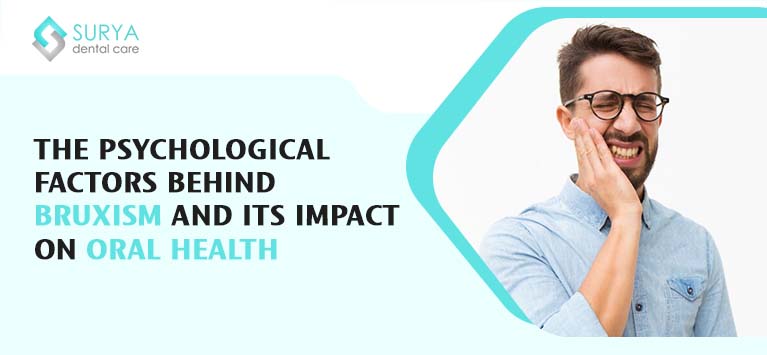Let’s look at how our feelings, like stress and anxiety, are linked to bruxism, a condition where people grind and clench their teeth. To treat bruxism effectively, it’s important to understand the connection between our emotions and this condition. Cognitive-behavioral therapy (CBT) is a big help here. It assists individuals in dealing with stress, changing how they act, and making their oral health better.
In this blog, we will explore how our emotions affect bruxism and see how CBT is a powerful tool for addressing this issue. It not only helps with stress but also helps people change their behavior and make their oral health better.
WHAT IS BRUXISM?
Bruxism is a movement disorder characterized by clenching and grinding of teeth, which can wear down tooth enamel. This can lead to dental problems and jaw or facial muscle pain. It can occur during sleep or when awake. Clenching is just closing the jaw muscles and holding the teeth together.
It can cause significant muscle strain, pain, and jaw joint injury. Teeth should only make brief contact during swallowing or chewing, as constant or forceful contact can erode the protective tooth enamel, potentially leading to dental issues.
Regular teeth clenching or grinding can also result in jaw and facial muscle pain. When you clench your teeth while you awake, it is called awake bruxism. When you clench your teeth in your sleep, it is called sleep bruxism. This will affect both kids and adults. It’s not severe in most cases unless the grinding and clenching of the teeth is frequent. This can lead to jaw disorder.
WHO WILL HAVE BRUXISM?
Bruxism can have various underlying causes, including emotional stress, such as anger and anxiety, drug usage, intense concentration, illness, dehydration, dietary factors, sleep disturbances, teething (in infants), misaligned teeth, and issues with dental treatments.
Additionally, some individuals may develop bruxism as a side effect of taking antidepressant medications. From this, we can understand that Psychology is an important aspect in understanding the causes of bruxism because, in many cases, it is linked to psychological and emotional factors.
WHY PEOPLE EXPERIENCE BRUXISM?
Stress and personality traits have been implicated in the development of bruxism, a condition characterized by clenching during wakefulness or grinding during sleep, often associated with heightened stress and anxiety. However, the precise mechanisms through which these psychological factors contribute to the onset of bruxism remain a subject of ongoing research.
Emotionally stressful states frequently trigger the physiological release of catecholamines, including epinephrine, norepinephrine, and dopamine. Interestingly, individuals with bruxism have been observed to exhibit elevated levels of these catecholamines in their urine compared to those without the condition. This suggests a potential link between stress-induced biochemical changes and bruxism.
It’s worth noting that much of the existing data on the relationship between psychological disorders and bruxism primarily relies on clinical assessments or self-reported information rather than in-depth investigations conducted in sleep laboratories.
This underscores the need for further scientific inquiry to gain a comprehensive understanding of how psychological factors interplay with the development of bruxism.
WHAT ARE THE CONSEQUENCES OF BRUXISM?
- The loss of tooth structure (dental attrition) is caused by the persistent grinding of teeth.
- Teeth can develop sensitivity, pain, and looseness when they are worn down or cracked due to grinding.
- Restricted jaw movement can result in discomfort while eating.
- Continuous teeth grinding can lead to flattened teeth, revealing the creamy-yellow dentine underneath.
- People might experience tenderness and discomfort in jaw muscles and joints when they wake up in the morning.
ROLE OF CBT IN ADDRESSING BRUXISM
Cognitive-behavioral therapy (CBT) is an effective treatment method utilized for addressing bruxism, as well as various psychological issues, such as stress and anxiety, which can contribute to the occurrence of teeth grinding.
This therapeutic approach is designed to assist individuals in making significant adjustments in both their thought processes and behaviors, ultimately equipping them with the necessary tools to proactively manage and mitigate their bruxism-related concerns.
Through CBT, individuals work closely with trained therapists to identify and understand the underlying thought patterns and triggers associated with their bruxism. This self-awareness allows them to gain insights into the connection between their emotional state and teeth-grinding episodes. Furthermore, CBT equips individuals with practical strategies and coping mechanisms to modify these patterns effectively.
One of the primary objectives of CBT is to help individuals reframe their thoughts and reactions concerning stress, anxiety, and other emotional factors. By doing so, they can learn to respond to these triggers in healthier and more constructive ways, reducing the likelihood of engaging in bruxism.
This therapy empowers individuals to develop adaptive techniques for managing their emotions, stressors, and anxieties, ultimately reducing the impact of these issues on their oral health.
CONCLUSION
A complete cure may not always be guaranteed, but CBT equips individuals with valuable tools to reshape thought patterns and behaviors, significantly reducing the severity and frequency of teeth grinding. Combining CBT with lifestyle modifications and dental treatments offers a comprehensive approach to improving oral health and overall well-being for those dealing with bruxism. However, long-term success often depends on continued stress management and adherence to treatment recommendations.







